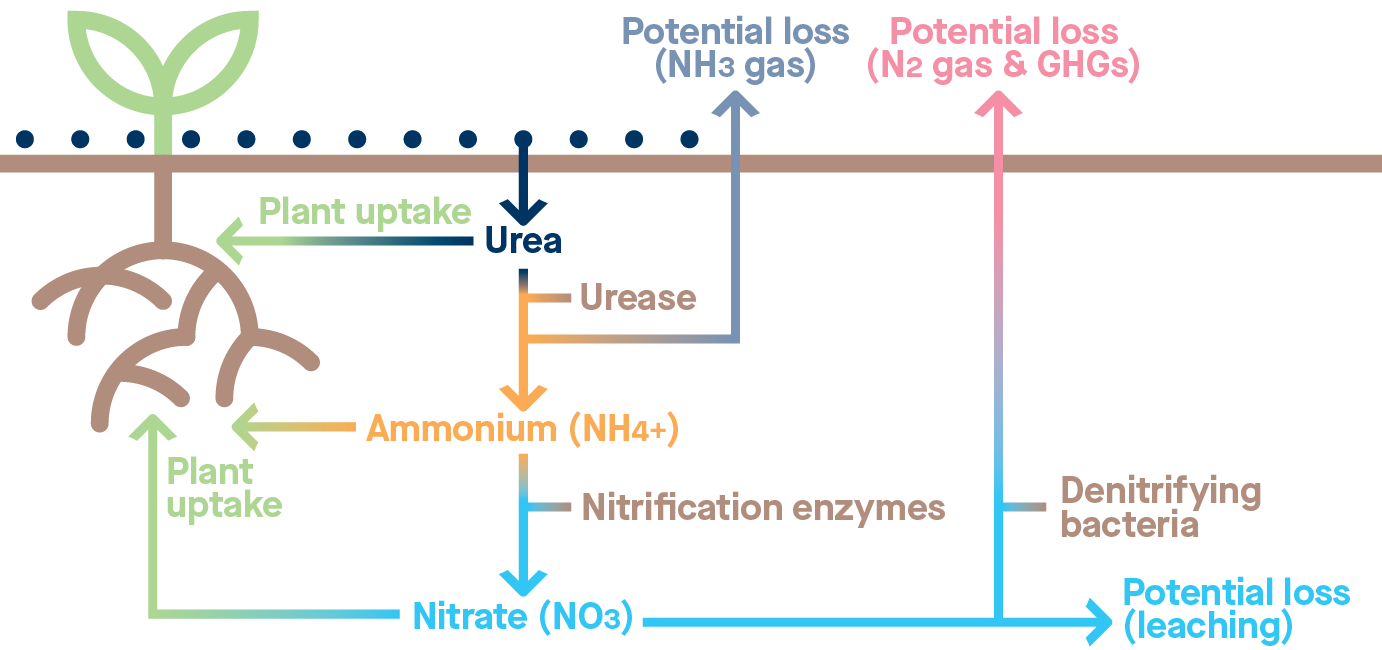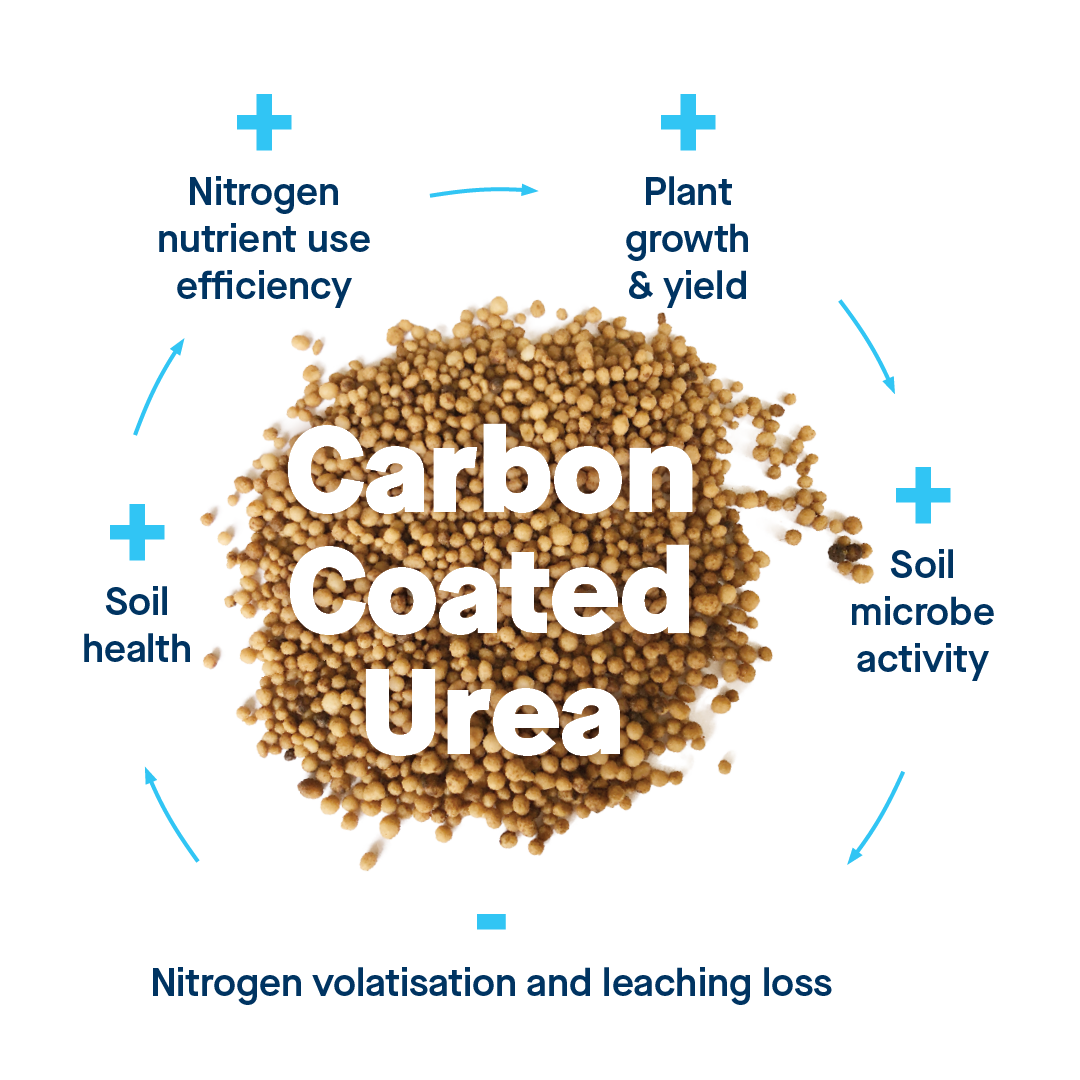Locking in bioavailable nitrogen with added humate
Urea is a nitrogen-rich molecule that is widely used in modern agriculture as an effective source of nitrogen for vigorous plant growth. However, urea is notoriously associated with large losses of nitrogen from agricultural systems because of leaching and volatilisation.
In a natural system, urea would enter the nitrogen cycle via animal urine, after which it is rapidly mineralised by soil microbes to ammonium (ammonification via the enzyme urease) and nitrate (nitrification via a combination of bacterial enzymes). Urea, ammonium and nitrate are all bioavailable nitrogen forms that can be taken up by plants (Witte 2011).
Urea is also produced industrially to satisfy the agricultural demand for nitrogen. The Haber-Bosch process uses energy from burning fossil fuels to react nitrogen gas from the atmosphere with hydrogen to form ammonia, which is then reacted with carbon dioxide to form urea. Large amounts of energy go into industrial urea production. To honour that, optimised urea use in agriculture should be the norm. Too often, nitrogen losses occur because excess urea is applied all at once that is too much to be taken up by growing plants.

Once spread, the nitrogen applied via urea can end up as a gaseous form and be lost from the soil. For example, urea spread without adequate incorporation (physical burying or washing into the soil) can be lost as the gas ammonia (NH3). This is because ammonia is a volatile intermediate molecule that evolves during the mineralisation of urea to ammonium (NH4+). Ammonia gas can be lost unless conditions allow it to react with soil water to form ammonium. Further nitrogen losses can occur in waterlogged soils, where bacteria that grow in low-oxygen environments carry out denitrification and convert nitrate (originating from urea conversion in the soil) to nitrogen gas (N2) that then re-enters the atmosphere.
Great results can be had with the synergy of urea and humate. This combination forms the basis of Carbon Coated Urea that is used as the primary nitrogen source in Ecogrowth fertiliser blends. Humate enhances urea by stabilising various nitrogen forms and stimulating the soil microbes that assist in nitrogen mineralisation. Boosted soil microbes can also absorb excess soil nitrogen into their own cells. When soil microbes grow, they use nitrogen to create biological macromolecules such as amino acids (protein) and nucleic acids (DNA etc) that are more stable in the soil than other nitrogen forms. Nitrogen taken up by soil microbes is not ‘locked up’, but rather stored in a biological bank that can be released to plants through what is commonly referred to as the ‘soil food web’.

The tried-and-tested approach of combining urea and humate is supported by numerous scientific reports. Across multiple field and pot trials, the combination of humate and urea has boosted plant yield, which is attributed to greater nitrogen stability in the soil and plant nitrogen supply (van Vuuren and Claassens 2009; Saha et al. 2019; Gao et al. 2022; Li et al. 2022). Moreover, reports show the use of humate with urea boosts microbial nitrogen cycling and decreases soil nitrogen losses, potentially via microbial sequestration of inorganic nitrogen (Espie and Ridgway 2020; Korsakov et al. 2023). The use of humate-enhanced urea, whereby humate is incorporated into the urea granule itself, is increasingly popular (Jing et al. 2022). Humate-enhanced urea results in greater plant growth (e.g., maize 11–21% increase in plant biomass) and yield (e.g., maize 5–18% increase in grain, silverbeet up to 88% increase in root dry weight) (Saha et al. 2019; Zhang et al. 2019). Humate-enhanced urea is also linked to greater plant nitrogen uptake (nitrogen use efficiency), and reduced soil nitrogen losses (Zhang et al. 2019; Saha et al. 2017; Saha et al. 2019).
Humates are complex chemical molecules that adsorb nutrients to their numerous chemically reactive functional groups. In particular, humates and comparable biochar materials adsorb ammonia (Reeza et al. 2009; Saha et al. 2019; Jiao et al. 2024). Surface-spread urea is stabilised by co-applying humate because nitrogen losses through ammonia volatilisation are reduced (Reeza et al. 2009; Saha et al. 2019).
The combined use of humate and urea, such as with Ecogrowth Carbon Coated Urea, contributes to optimal plant growth and vigour. Carbon Coated Urea marries an effective nitrogen supply with soil conditioning, soil microbe stimulation, and greater nutrient use efficiency.
References:
Espie, Peter, and Haley Ridgway. 2020. ‘Bioactive carbon improves nitrogen fertiliser efficiency and ecological sustainability’, Scientific Reports, 10: 3227.
Gao, F., Z. L. Li, Y. P. Du, J. H. Duan, T. J. Zhang, Z. B. Wei, L. Guo, W. N. Gong, Z. G. Liu, and M. Zhang. 2022. ‘The Combined Application of Urea and Fulvic Acid Solution Improved Maize Carbon and Nitrogen Metabolism’, Agronomy-Basel, 12.
Jiao, Y. H., J. Huang, J. Hu, A. J. Weatherley, W. Liu, C. Y. Li, Z. L. Ma, and B. Han. 2024. ‘Abating ammonia emission from poultry manure by Pt/TiO2 modified corn straw’, Journal of Environmental Management, 350: 11.
Jing, Jianyuan, Shuiqin Zhang, Liang Yuan, Yanting Li, Yingqiang Zhang, Yanchen Wen, and Bingqiang Zhao. 2022. ‘Humic acid complex formation with urea alters its structure and enhances biomass production in hydroponic maize’, Journal of the Science of Food and Agriculture, 102: 3636-43.
Korsakov, K., A. Stepanov, L. Pozdnyakov, and O. Yakimenko. 2023. ‘Humate-Coated Urea as a Tool to Decrease Nitrogen Losses in Soil’, Agronomy-Basel, 13: 12.
Li, Zeli, Qi Chen, Feng Gao, Qingmin Meng, Mingyang Li, Yan Zhang, Peng Zhang, Min Zhang, and Zhiguang Liu. 2022. ‘Controlled-release urea combined with fulvic acid enhanced carbon/nitrogen metabolic processes and maize growth’, Journal of the Science of Food and Agriculture, 102: 3644-54.
Reeza, Ameera Abdul, Osumanu Haruna Ahmed, Nik Muhamad Nik Ab Majid, and Mohamadu Boyie Jalloh. 2009. ‘Reducing Ammonia Loss from Urea by Mixing with Humic and Fulvic Acids Isolated from Coal’, American Journal of Environmental Sciences, 5.
Saha, B. K., M. T. Rose, V. N. L. Wong, T. R. Cavagnaro, and A. F. Patti. 2019. ‘A slow release brown coal-urea fertiliser reduced gaseous N loss from soil and increased silver beet yield and N uptake’, Science of the Total Environment, 649: 793-800.
Saha, Biplob K., Michael T. Rose, Vanessa Wong, Timothy R. Cavagnaro, and Antonio F. Patti. 2017. ‘Hybrid brown coal-urea fertiliser reduces nitrogen loss compared to urea alone’, Science of the Total Environment, 601-602: 1496-504.
van Vuuren, J. A. J., and A. S. Claassens. 2009. ‘Greenhouse Pot Trials to Determine the Efficacy of Black Urea Compared to Other Nitrogen Sources’, Communications in Soil Science and Plant Analysis, 40: 576-86.
Witte, Claus-Peter. 2011. ‘Urea metabolism in plants’, Plant Science, 180: 431-38.
Zhang, S. Q., L. Yuan, W. Li, Z. A. Lin, Y. T. Li, S. W. Hu, and B. Q. Zhao. 2019. ‘Effects of urea enhanced with different weathered coal-derived humic acid components on maize yield and fate of fertilizer nitrogen’, Journal of Integrative Agriculture, 18: 656-66.